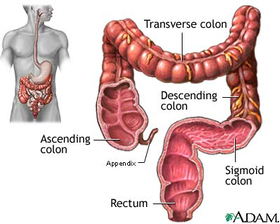Low Rectal Cancer
How your Colon Work
The colon is a 6-foot long muscular tube that connects the small intestine to the rectum. The large intestine is made up of the cecum, the ascending (right) colon, the transverse (across) colon, the descending (left) colon and the sigmoid colon, which connects to the rectum. The appendix is a small tube attached to the cecum. The large intestine is a highly specialized organ that is responsible for processing waste so that emptying the bowels is easy and convenient.
 Stool, or waste left over from the digestive process, is passed through the colon by means of peristalsis, first in a liquid state and ultimately in a solid form. As stool passes through the colon, water is removed. Stool is stored in the sigmoid colon until a "mass movement" empties it into the rectum once or twice a day. It normally takes about 36 hours for stool to get through the colon. The stool itself is mostly food debris and bacteria. These bacteria perform several useful functions, such as synthesizing various vitamins, processing waste products and food particles, and protecting against harmful bacteria. However, the primary function of the colon is to remove water from the stool as it moves through the colon so that it is in a solid or semi solid state once it reaches the rectum. When the descending colon becomes full of stool, or feces, it empties its contents into the rectum to begin the process of elimination.
Stool, or waste left over from the digestive process, is passed through the colon by means of peristalsis, first in a liquid state and ultimately in a solid form. As stool passes through the colon, water is removed. Stool is stored in the sigmoid colon until a "mass movement" empties it into the rectum once or twice a day. It normally takes about 36 hours for stool to get through the colon. The stool itself is mostly food debris and bacteria. These bacteria perform several useful functions, such as synthesizing various vitamins, processing waste products and food particles, and protecting against harmful bacteria. However, the primary function of the colon is to remove water from the stool as it moves through the colon so that it is in a solid or semi solid state once it reaches the rectum. When the descending colon becomes full of stool, or feces, it empties its contents into the rectum to begin the process of elimination.
Educate Yourself
Colonic Function A short article on function of the colon
Anatomy of Colon and Rectum A brief description and a lot of endoscope pictures
Explore on Goggle with these key words:Colon, Bowel, Digestion